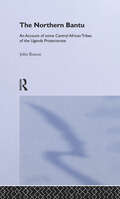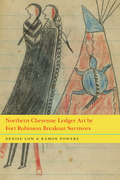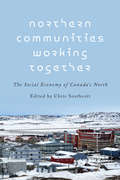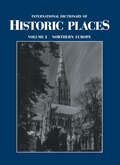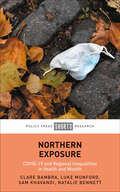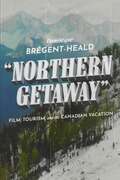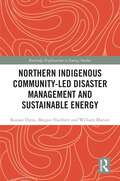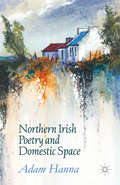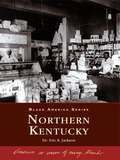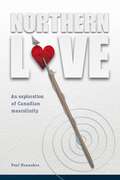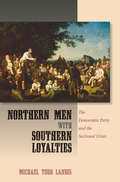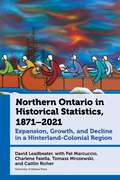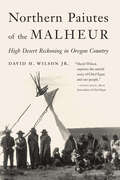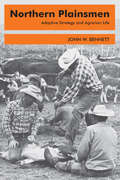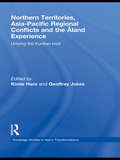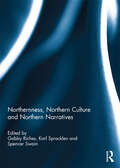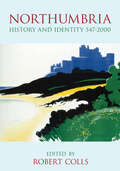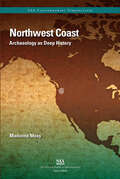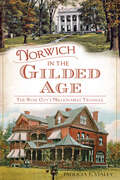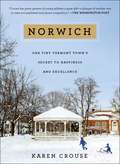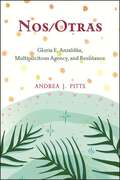- Table View
- List View
Northern Bantu: An Account of Some Central African Tribes of the Uganda Protectorate (Cambridge Library Collection - Anthropology Ser.)
by John RoscoeFirst Published in 1966. Routledge is an imprint of Taylor & Francis, an informa company.
Northern Cheyenne Ledger Art by Fort Robinson Breakout Survivors
by Denise Low Ramon PowersNorthern Cheyenne Ledger Art by Fort Robinson Breakout Survivors presents the images of Native warriors—Wild Hog, Porcupine, and Left Hand, as well as possibly Noisy Walker (or Old Man), Old Crow, Blacksmith, and Tangled Hair—as they awaited probable execution in the Dodge City jail in 1879. When Sheriff Bat Masterson provided drawing materials, the men created war books that were coded to avoid confrontation with white authorities and to narrate survival from a Northern Cheyenne point of view. The prisoners used the ledger-art notebooks to maintain their cultural practices during incarceration and as gifts and for barter with whites in the prison where they struggled to survive. The ledger-art notebooks present evidence of spiritual practice and include images of contemporaneous animals of the region, hunting, courtship, dance, social groupings, and a few war-related scenes. Denise Low and Ramon Powers include biographical materials from the imprisonment and subsequent release, which extend the historical arc of Northern Cheyenne heroes of the Plains Indian Wars into reservation times. Sources include selected ledger drawings, army reports, letters, newspapers, and interviews with some of the Northern Cheyenne men and their descendants. Accounts from a firsthand witness of the drawings and composition of the ledgers themselves give further information about Native perspectives on the conflicted history of the North American West in the nineteenth century and beyond. This group of artists jailed after the tragedy of the Fort Robinson Breakout have left a legacy of courage and powerful art.
Northern Communities Working Together
by Chris SouthcottThe unique historical, economic, and social features of the Canadian North pose special challenges for the social economy - a sector that includes nonprofits, co-operatives, social enterprises, and community economic development organizations. Northern Communities Working Together highlights the innovative ways in which Northerners are using the social economy to meet their economic, social, and cultural challenges while increasing local control and capabilities. The contributors focus on the special challenges of the North and their impact on the scope of the social economy, including analyses of land claim organizations, hunter support programs, and Indigenous conceptions of the social economy.A welcome resource for scholars and policy-makers studying any aspect of the Canadian North, Northern Communities Working Together is a major contribution to the literature on the social economy in Canada.
Northern Europe: International Dictionary of Historic Places
by Trudy RingFirst published in 1996. Routledge is an imprint of Taylor & Francis, an informa company.
Northern European Reformations: Transnational Perspectives
by James E. Kelly Henning Laugerud Salvador RyanThis book examines the experiences and interconnections of the Reformations, principally in Denmark-Norway and Britain and Ireland (but with an eye to the broader Scandinavian landscape as well), and also discusses instances of similarities between the Reformations in both realms. The volume features a comprehensive introduction, and provides a broad survey of the beginnings and progress of the Catholic and Protestant Reformations in Northern Europe, while also highlighting themes of comparison that are common to all of the bloc under consideration, which will be of interest to Reformation scholars across this geographical region.
Northern Exposure: COVID-19 and Regional Inequalities in Health and Wealth
by Clare Bambra Luke Munford Sam Khavandi Natalie BennettEPDF and EPUB available Open Access under CC-BY-NC-ND licence. Whilst the COVID-19 pandemic affected all parts of the country, it did not do so equally. Northern England was hit the hardest, exposing more than ever the extent of regional inequalities in health and wealth. Using original data analysis from a wide range of sources, this book demonstrates how COVID-19 has impacted the country unequally in terms of mortality, health care, mental health, and the economy. The book provides a striking empirical overview of the impact of the pandemic on regional inequalities and explores why the North fared worse. It sets out what needs to be learnt from the pandemic to prevent regional inequality growing and to reduce inequalities in health and wealth in the future.
Northern Getaway: Film, Tourism, and the Canadian Vacation
by Dominique Brégent-HealdFor more than a century, posters, advertisements, and brochures have characterized Canada as a desirable tourist destination offering spectacular scenery, wild animals, outdoor recreation, and state-of-the-art accommodations. However, these explicitly commercial displays are not the only marketing tools at the country’s disposal; beginning in the 1890s, film also played a role in selling Canada.In Northern Getaway Dominique Brégent-Heald investigates the connections between film and tourism during the first half of the twentieth century, exploring the economic, pedagogical, geopolitical, and socio-cultural contexts and aspirations of tourism films. From the first moving images of the 1890s through the end of the 1950s, a complex web of public and private stakeholders in Canadian tourism experimented, sometimes in collaboration with Hollywood, with a variety of film forms – 16 mm or 35 mm, feature or short films, fiction or nonfiction, professional or amateur filmmakers – to promote Canada. Spectators, particularly Americans, saw Canada as a tourist destination on screens in motion picture theatres, schools, and fairgrounds. Rooted in settler colonial representations that celebrate the nation’s unspoiled but welcoming wilderness landscapes, these films also characterize Canada as a technologically and industrially advanced settler country.Using evidence from a wide range of archival sources and drawing from current scholarship in film history and tourism studies, Northern Getaway demonstrates how Canada was an innovator in using film to shape and project a recognizable destination brand.
Northern Indigenous Community-Led Disaster Management and Sustainable Energy (Routledge Explorations in Energy Studies)
by Ranjan Datta Margot Hurlbert William MarionThis book examines how current energy and water management processes affect Indigenous communities in North America, with a specific focus on Canada. Currently, there is no known Indigenous community-led strategic environmental assessment (ICSEA) tool for developing community-led solutions for pipeline leak management and energy resiliency. To fill this lacuna, this book draws on expertise from Indigenous Elders, Knowledge-keepers, and leaders representing communities who are highly affected by pipeline leaks. These accounts highlight the importance of providing Indigenous communities with technical information and advice, allowing them to practise community-led disaster management, and giving them direct access to lawyers and decision-makers. If implemented into current policy and practice, these tools would succeed in helping rural Indigenous communities make strategic choices for sustainable energy management and utilize their lands, traditional territories, and natural resources to develop a robust, sustainable energy future. Prioritizing Indigenous perspectives on energy management and governance, this book will be of great interest to students, scholars, and practitioners working in the fields of energy policy and justice, environmental sociology, and Indigenous studies.
Northern Ireland: Society Under Siege
by Rona M. FieldsThe troubles in Ireland are not new. They have taken a heavy toll in lives and, perhaps more importantly, in psychological health. This book is not concerned with events in themselves, although it includes historical analysis of the conflict in Northern Ireland. It does attempt to discover the human effects of long-term conflicts such as those occurring in Ireland. From testing and interviews with the children, women, and men of Northern Ireland beginning in 1969, the author has developed a case study of the long-term effects of stress on a population. She identifies certain social control mechanisms that produce a mixture of chaos and docility in the troubled North and argues that England has established these in order to destroy the identity of the people—a process she calls "psychological genocide.", Northern Ireland: Society Under Siege applies social-psychological theory to a concrete and ongoing situation in a way that is illuminating for the general reader and for the specialist. Dr. Fields has done what might appear obvious: find out the effects of stress on a population by going to that population and observing what their lives are like. The remarkable fact is, however, that until now no one has done so., ...a wide-ranging and perceptive book.... A significant thrust and contribution of this book is Fields' discussion of psychological and social control procedures and practices....(Fields') report is a challenge to humanity and an indictment of English patricianism, racism, and imperialism. Alfred McClung Lee, Dr. Rona Field is a brave and deeply compassionate human being, a committed researcher who cannot be intimidated by gunmen, English soldiers, bigots, ferocious politicians, or the horrors of confronting human suffering in dreadful forms. This valiant woman deserves international praise and recognition for the unflinching study of a tragic society. Dennis Clark, National Catholic Reporter
Northern Irish Poetry and Domestic Space
by Adam HannaNorthern Irish Poetry and Domestic Space explores why houses, in some ways the most private of spaces, have taken up such visibly public positions in the work of a range of prominent poets from Northern Ireland, examining the work of Seamus Heaney, Michael Longley, Derek Mahon and Medbh McGuckian.
Northern Kentucky (Black America Series)
by Dr Eric JacksonAlong the picturesque southern banks of the Ohio River, the African-American communities of Boone, Campbell, and Kenton Counties have provided laborers and entrepreneurs to aid in the economic growth of the region from the earliest settlements to today. Despite numerous obstacles and against seemingly insurmountable odds, African Americans in Northern Kentucky made significant contributions in many fields, ranging from music, medicine, and literature to performing arts, poetry, education, and athletics.
Northern Love: An exploration of Canadian Masculinity
by Paul NonnekesIn Northern Love, Paul Nonnekes proposes a conception of love suggestive of a distinctive model of Canadian masclinity. He pursues debates in psychoanalysis and cultural theory in relation to two representative male characters in novels by Rudy Wiebe (A Discovery of Strangers) and Robert Kroetsch (The Man from the Creeks</em). Ranging from debates on the Hegelian master-slave dialectic to the Lacanian Name of the Father, and from Butler's strange gender to Zizek's subjective awareness of lack, Nonnekes probes the two novels and their main characters, eliciting an evolving conception of love characteristic of the Canadian cultural imaginary.
Northern Men with Southern Loyalties: The Democratic Party and the Sectional Crisis
by Michael Todd LandisIn the decade before the Civil War, Northern Democrats, although they ostensibly represented antislavery and free-state constituencies, made possible the passage of such proslavery legislation as the Compromise of 1850 and Fugitive Slave Law of the same year, the Kansas-Nebraska Act of 1854, and the Lecompton Constitution of 1858. In Northern Men with Southern Loyalties, Michael Todd Landis forcefully contends that a full understanding of the Civil War and its causes is impossible without a careful examination of Northern Democrats and their proslavery sentiments and activities. He focuses on a variety of key Democratic politicians, such as Stephen Douglas, William Marcy, and Jesse Bright, to unravel the puzzle of Northern Democratic political allegiance to the South. As congressmen, state party bosses, convention wire-pullers, cabinet officials, and presidents, these men produced the legislation and policies that led to the fragmentation of the party and catastrophic disunion. Through a careful examination of correspondence, speeches, public and private utterances, memoirs, and personal anecdotes, Landis lays bare the desires and designs of Northern Democrats. He ventures into the complex realm of state politics and party mechanics, drawing connections between national events and district and state activity as well as between partisan dynamics and national policy. Northern Democrats had to walk a perilously thin line between loyalty to the Southern party leaders and answering to their free-state constituents. If Northern Democrats sought high office, they would have to cater to the "Slave Power." Yet, if they hoped for election at home, they had to convince voters that they were not mere lackeys of the Southern grandees.
Northern Ontario in Historical Statistics, 1871–2021: Expansion, Growth, and Decline in a Hinterland-Colonial Region (Canadian Studies #10)
by Professor David LeadbeaterBased on original historical tables, Northern Ontario in Historical Statistics, 1871–2021 offers an overview of major long-term population, social composition, employment, and urban concentration trends over 150 years in the region now called “Northern Ontario” (or “Nord de l’Ontario”). David Leadbeater and his collaborators compare Northern Ontario relative to Southern Ontario, as well as detail changes at the district and local levels. They also examine the employment population rate, unemployment, economic dependency, and income distribution, particularly over recent decades of decline since the 1970s.Although deeply experienced by Indigenous peoples, the settler-colonial structure of Northern Ontario’s development plays little explicit analytical role in official government discussions and policy.Northern Ontario in Historical Statistics, 1871–2021, therefore, aims to provide context for the long-standing hinterland colonial question: How do ownership, control, and use of the land and its resources benefit the people who live there?Leadbeater and his collaborators pay special attention to foundational conditions in Northern Ontario’s hinterland-colonial development including Indigenous relative to settler populations, treaty and reserve areas, and provincially controlled “unorganized territories.” Colonial biases in Canadian censuses are discussed critically as a contribution towards decolonizing changes in official statistics.
Northern Paiutes of the Malheur: High Desert Reckoning in Oregon Country
by David H. Wilson Jr.In 1870 a twenty-six-year-old Paiute, Sarah Winnemucca, wrote to an army officer requesting that Paiutes be given a chance to settle and farm their ancestral land. The eloquence of her letter was such that it made its way into Harper&’s Weekly. Ten years later, as her people languished in confinement as a result of the Bannock War, she convinced Secretary of the Interior Carl Schurz to grant the requests in her letter and free the Paiutes as well. Schurz&’s decision unleashed furious opposition from the Bureau of Indian Affairs, cattlemen, and settlers. A campaign of disinformation by government officials followed, sweeping truth aside and falsely branding Paiute chief Egan as instigator and leader of the Indian forces. The campaign succeeded in its mission to overturn Schurz&’s decision. To this day histories of the war appear to be unanimous in their mistaken claim that Egan led his Paiutes into war. Indian agents&’ betrayal of the people they were paid to protect saddled Paiutes with responsibility for a war that most opposed and that led to U.S. misappropriation of their land, their only source of life&’s necessities. With neither land nor reservation, Paiutes were driven more deeply into poverty and disease than any other Natives of that era. David H. Wilson Jr. pulls back the curtain to reveal what government officials hid—exposing the full jarring injustice and, after 140 years, recounting the Paiutes&’ true and proud history for the first time.
Northern Plainsmen: Adaptive Strategy and Agrarian Life
by John W. BennettA study of a rural region and plural society, this book is a distinctive contribution to anthropology, in that it brings the conceptual framework of that discipline to bear on a contemporary agrarian society and its historical development, rather than on peasant or tribal peoples; cultural ecology, in that it shows the nature of the adaptations of four distinctive social groups to the environment of the Canadian Great Plains; the study of social and economic change, as it describes cultural patterns and mechanisms that are relevant to agrarian development the world over; and North American studies, in as much as it deals with community life in the classic sequence of settlement of the Western Plains.The book is, focused throughout on the adaptation of human societies to their environment. Four groups are described: the Cree Indians, the aboriginal inhabitants of the area who have lost all organic relationship to natural resources and who have devised ingenious methods for manipulating the social environment; ranchers, whose specialized production is based upon resources used in their natural state; homestead farmers, whose maladjusted small-farm economy, after initial setbacks, achieved a degree of stability through interventions by government in their adaptations to nature and the market economy; and the Hutterian Brethren, whose adaptation consisted primarily of the introduction to the region of a new kind of social organization.This book combines the anthropological concept of culture and the framework of ecology in the study of a modern social milieu; it focuses on a region rather than on a single culture, people, or community, so that the interplay of several social groups can be appreciated; and it elaborates contemporary anthropological and ecological theory in a manner that makes it applicable to the understanding of contemporary agrarian societies.John W. Bennett was emeritus professor of anthropology at Washington University, St. Louis. He served as presid
Northern Territories, Asia-Pacific Regional Conflicts and the Aland Experience: Untying the Kurillian Knot (Routledge Studies in Asia's Transformations)
by Geoffrey Jukes Kimie HaraThis volume is the fruit of an international collaborative study, which considers the Åland islands settlement in northern Europe as a resolution model for the major Asia-Pacific regional conflicts that derived from the post-World War II disposition of Japan, with particular focus on the territorial dispute between Japan and Russia, the Northern Territories/Southern Kuriles problem. The contributors provide analysis of the Åland settlement, the Japan-Russia territorial dispute and Åland-inspired solution ideas by experts from all over the world, including government officials, scholars and military specialists. Northern Territories, Asia-Pacific Regional Conflicts and the Aland Experience will be of interest to advanced undergraduate and postgraduate students, as well as academics working in Asian studies, politics, international relations, conflict resolution and security studies.
Northernness, Northern Culture and Northern Narratives
by Gabby Riches, Karl Spracklen and Spencer SwainNorthernness, Northern culture and Northern narratives are a common aspect of popular culture, and the North of England, like other Northernnesses in Europe, is a collection of narratives, myths, stereotypes and symbols. In politics and everyday culture, Northern culture is paradoxically a site of resistance against an inauthentic South, a source of working-class identity, and a source of elite marginalisation. This book provides a key to theorising about Northernness, and a platform to scholars working away at exposing the North in different aspects of culture. The aims of this book are twofold: to re-theorise ‘the North’ and Northern culture and to highlight the ways in which constructions of Northernness and Northern culture are constituted alongside other gender, racial and regional identities. The contributions presented here theorise Northernness in relation to space, leisure, gender, race, class, social realism, and everyday embodied practices. A main thematic thread that weaves the whole book together is the notion that Northernness and ‘the North’ is both an imagined discursive construct and an embodied subjectivity, thus creating a paradox between the reality of ‘North’ and its representation. This book was originally published as a special issue of the Journal for Cultural Research.
Northumbria: History and Identity 547-2000
by Robert CollsTHE NORTH EAST is probably England’s most distinctive region. A place of strong character with a very special sense of its past, it is, as William Hutchinson remarked in 1778, ‘truly historical ground’. This is a book about both the ancient Anglian kingdom of Northumbria, which stretched from the Humber to the Scottish border, and the ways in which the idea of being a Northumbrian, or a northerner, or someone from the ‘North East’, persisted in the area long after the early English kingdom had fallen. It examines not only the history of the region, but also the successive waves of identity that history has bestowed over a very long period of time. Northumbria existed before ‘England’ began but is with us still in name, and in the way we think about ourselves. A series of sections, entitled Christian Kingdom, Borderland and Coalfield, New Northumbria, Cultural Region and Northumbrian Island, explore the region on the grand scale, from its very beginning, and bring a sharp sense of history to bear on the various threads that have influenced the making of modern regional identity. The book is a work of exceptional scholarship. Never before have so many leading historians addressed together the issues which have affected this special region. Clearly written, and rich in ideas, chapters explore the physical origins of Northumbria and consider just how the pressing political and military claims of adjoining states shaped and tempered it. There are further chapters on art, music, mythology, dialect, history, economy, poetry, politics, religion, antiquarianism, literature and settlement. They show how Northumbrians have lived and died, and looked forward and back, and these accounts of the North East’s past will surely help in the shaping of its future. Front cover illustration taken from LNER poster ‘Northumberland: It’s Quicker By Rail’, and reproduced courtesy of the Science & Society Picture Library. Back cover illustration shows coalminers working the chock at Cambois Colliery and is reproduced courtesy of the Six Townships Community History Group in Bedlingtonshire.
Northwest Coast: Archaeology as Deep History (SAA Current Perspectives)
by Madonna L. MossFrom the SAA Press Current Perspectives Series, this concise overview of the archeology of the Northwest Coast of North America challenges stereotypes about complex hunter-gatherers. Madonna Moss argues that these ancient societies were first and foremost fishers and food producers and merit study outside socio-evolutionary frameworks. Moss approaches the archaeological record on its own terms, recognizing that changes through time often reflect sampling and visibility of the record itself. The book synthesizes current research and is accessible to students and professionals alike.
Northwest Europe in the Early Middle Ages, c. AD 600-1150
by Christopher LoveluckChristopher Loveluck's study explores the transformation of Northwest Europe (primarily Britain, France and Belgium) from the era of the first post-Roman 'European Union' under the Carolingian Frankish kings to the so-called 'feudal' age, between c. AD 600 and 1150. During these centuries radical changes occurred in the organisation of the rural world. Towns and complex communities of artisans and merchant-traders emerged and networks of contact between northern Europe, the Mediterranean, and the Middle and Far East were redefined, with long-lasting consequences into the present day. Loveluck provides the most comprehensive comparative analysis of the rural and urban archaeological remains in this area for twenty-five years. Supported by evidence from architecture, relics, manuscript illuminations and texts, this book explains how the power and intentions of elites were confronted by the aspirations and actions of the diverse rural peasantry, artisans and merchants, producing both intended and unforeseen social changes.
Norway To America: A History of the Migration
by Ingrid SemmingsenThis book tells the story of the migration as it affected both countries and investigates the reasons for &“American Fever.&” The story ends with a discussion of the ways in which Norwegian-Americans retain their ties to Norway. The book was first published in Norway as Dröm og Dad (Dream and Deed), in observance of the 150th anniversary of the departure of the first emigrant ship for America. This is an excellent way to celebrate one of the strongest ethnic heritages in America.
Norwich in the Gilded Age: The Rose City's Millionaires' Triangle (Landmarks Ser.)
by Patricia F StaleyA photo-filled history of Norwich, Connecticut, and the families, fashions, and fortunes of its elite nineteenth-century residents. Stroll down Norwich&’s most fashionable mile of millionaires&’ mansions and mingle with the extraordinary people who lived and played behind their elegant facades during the glamorous Gilded Age. Wealthy manufacturers and merchants constructed magnificent mansions, many of which survive today, along this trendiest triangle in the glitzy &“Rose of New England,&” conveniently nestled between Boston and New York. Tricia Staley has uncovered forgotten scandals like the Blackstone baby kidnapping and the bank cashiers who embezzled thousands of dollars from wealthy residents, as well as the drama of fortunes made and lost. Meet Tiffany&’s founding partner John Young, rubber shoe manufacturing king William A. Buckingham, the Slaters, Greenes, and Hubbards, and more salacious, stylish titans of industry and extravagance.
Norwich: One Tiny Vermont Town's Secret to Happiness and Excellence
by Karen CrouseThe extraordinary story of the small Vermont town that has likely produced more Olympians per capita than any other place in the country—and whose citizens provide a model for achieving excellence while leading a well-rounded life.Norwich, a charming Vermont town of roughly three thousand residents, has sent an athlete to almost every Winter Olympics for the past thirty years—and three times that athlete has returned with a medal. How does Norwich do it? To answer this question, New York Times reporter Karen Crouse moved to Vermont, immersing herself in the lives of Norwich Olympians past and present. There, amidst the organic farms and clapboard colonial buildings, she discovered a culture that’s the opposite of the hypercompetitive schoolyard of today’s tiger moms and eagle dads. In Norwich, kids aren’t cut from teams. They don’t specialize in a single sport, and they even root for their rivals. What’s more, their hands-off parents encourage them to simply enjoy themselves. Making it to the Olympics is seen not as the pinnacle of an athlete’s career but as a fun stop on the way to achieving other, longer-lasting dreams. Norwich, Crouse realized, wasn’t just raising better athletes than the rest of America; it was raising happier, healthier kids. Full of inspiring stories of Olympians who excelled on and off the sports field—and had a blast doing so—Norwich is the book for every parent who wants to raise kids to be levelheaded, fulfilled, and successful.
Nos/Otras: Gloria E. Anzaldúa, Multiplicitous Agency, and Resistance (SUNY series, Philosophy and Race)
by Andrea J. PittsIn a refreshingly novel approach to the writings of Gloria E. Anzaldúa (1942–2004), Andrea J. Pitts addresses issues relevant to contemporary debates within feminist theory and critical race studies. Pitts explores how Anzaldúa addressed, directly and indirectly, a number of complicated problems regarding agency in her writings, including questions of disability justice, trans theorizing, Indigenous sovereignty, and identarian politics. Anzaldúa's conception of what Pitts describes as multiplicitous agency serves as a key conceptual link between these questions in her work, including how discussions of agency surfaced in Anzaldúa's late writings of the 1990s and early 2000s. Not shying away from Anzaldúa's own complex and sometimes problematic framings of disability, mestizaje, and Indigeneity, Pitts draws from several strands of contemporary Chicanx, Latinx, and African American philosophy to examine how Anzaldúa's work builds pathways toward networks of solidarity and communities of resistance.
